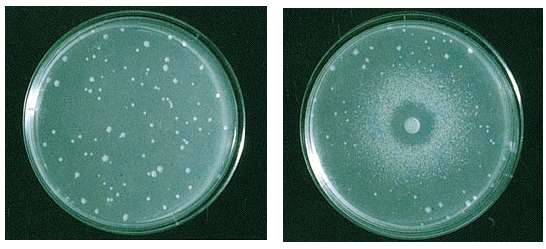
Reversion
mutations in his- Salmonella
bacteria
The dish on the left
was plated with ~109 his- Salmonella
bacteria, which cannot grow in the absence of the
amino acid histidine. In
this control experiment, the small number (~102) of
white colonies are derived from single bacteria that have
undergone spontaneous reversion
mutations to his+. The reversion test is
thus extremely sensitive, because it can detect mutation rates as
small as 1/109-2 = 10-7/ cell.
In the experiment on the right, the disc at the
center of the dish contains a mutagenic chemical. As it diffuses
outward, the chemical at high concentration is toxic and at first
kills all the bacteria (clear circle around the disc), but at
lower concentrations gives rise to induced reversion
mutations, seen as many 103s of revertant ( his+)
colonies. As the concentration continues to decrease towards the
outer edge of the plate, the frequency of revertant colonies falls
to about the same as in the control experiment at left. In cell
culture, it is therefore possible to measure the precise degree of
mutagenicity at a range of concentrations.
The Ames Test uses the
bacterial reversion assay to measure
mutagenicity as the difference between the induced and spontaneous rates of
reversion mutation at various concentrations of the mutagenic
substance.

